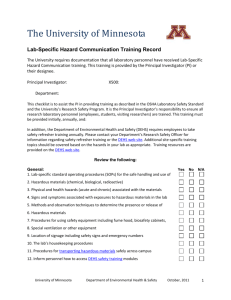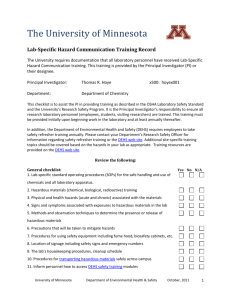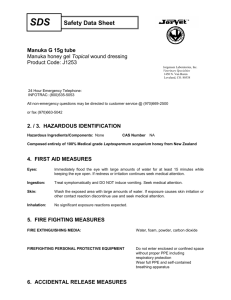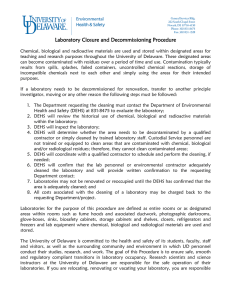Laboratory Construction - Office of the Vice President for Research
advertisement
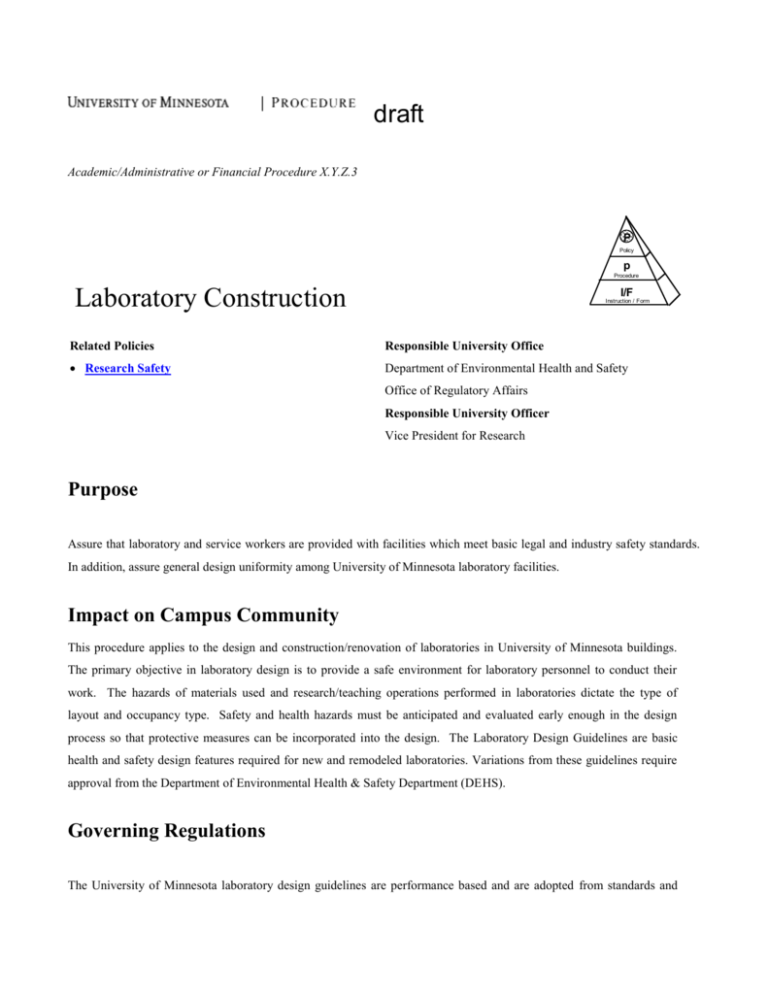
draft Academic/Administrative or Financial Procedure X.Y.Z.3 P Policy p Procedure Laboratory Construction I/F Instruction / Form Related Policies Responsible University Office Research Safety Department of Environmental Health and Safety Office of Regulatory Affairs Responsible University Officer Vice President for Research Purpose Assure that laboratory and service workers are provided with facilities which meet basic legal and industry safety standards. In addition, assure general design uniformity among University of Minnesota laboratory facilities. Impact on Campus Community This procedure applies to the design and construction/renovation of laboratories in University of Minnesota buildings. The primary objective in laboratory design is to provide a safe environment for laboratory personnel to conduct their work. The hazards of materials used and research/teaching operations performed in laboratories dictate the type of layout and occupancy type. Safety and health hazards must be anticipated and evaluated early enough in the design process so that protective measures can be incorporated into the design. The Laboratory Design Guidelines are basic health and safety design features required for new and remodeled laboratories. Variations from these guidelines require approval from the Department of Environmental Health & Safety Department (DEHS). Governing Regulations The University of Minnesota laboratory design guidelines are performance based and are adopted from standards and practices recommended by the national standards organizations listed below. They have been developed based on practical experience in the design of buildings, equipment and components associated with laboratories. They are also intended to facilitate compliance with statutory requirements for highly regulated materials such as biologically hazardous Select Agents or use of radioactive material. American National Standard for Emergency Eyewash and Shower Equipment (ANSI Standards Z358.1) Industrial Safety Equipment Association NY American National Standards Institute (ANSI) Telephone: 212-642-4900 American Society of Hospital Engineering, all volumes American Hospital Association 840 North Lake Shore Drive Chicago, IL 60611 ASHRAE Handbook and Standards American Society of Heating, Refrigerating and Air-Conditioning Engineers (ASHRAE) Inc. 1791 Tullie Circle NE Atlanta, GA 30329 Telephone: 404-636-8400 Guide for the Care and Use of Laboratory Animals U.S. Department of Health and Human Services Bethesda, MD National Institute of Health, Publication No. 86-23 Telephone: 202-783-3238 Guidelines for Construction and Equipment of Hospital and Medical Facilities The American Institute of Architects Committee on Architecture for Health with assistance from the U.S. Department of Health and Human Services American Institutes of Architects Press 1735 New York Avenue, NW Washington, DC 20006 Telephone: 800-365-2724 Guidelines for Research Involving Recombinant DNA Molecules U.S. Department of Health and Human Services U.S. Public Health Services National Institutes of Health Federal Register/Vol. 51, No. 88: 16957-16985 Bethesda, MD: National Institute of Health (NIH) Telephone: 301-496-9838 Biosafety in Microbiological and Biomedical Laboratories (BMBL) 5th Edition (Feb 2007) U.S. Department of Health and Human Services Centers for Disease Control and Prevention and National Institutes of Health US Government Printing Office IES-RP-CCOO2 Institute of Environmental Science Industrial Ventilation: A Manual of Recommended Practice American Conference of Governmental Industrial Hygienists 6500 Glenway Avenue, Building D-7 Cincinnati, OH 45211 Medical Laboratory Planning and Design College of American Pathologists Skokie, IL Telephone: 708-446-8800, Ext. 531 National Fire Codes Refer to specific standards 45, 99 National Fire Protection Association (NFPA) 1 Batterymarch Park Quincy, MA 02269-9101 Telephone: 617-770-3000 NIH Design Policy and Guidelines Design Criteria for Research Laboratories NIH Design Policy and Guidelines Design Criteria for Research Laboratory Mechanical Systems Occupational Safety and Health Standards CFR 29, Part 1910 U.S. Department of Labor Occupational Safety and Health Administration (OSHA) Telephone: 202-783-3238 Standard 49 for Class II (Laminar Flow) Biohazard Cabinetry National Sanitation Foundation Joint Committee on Biohazard Cabinetry Ann Arbor, MI: National Sanitation Foundation Telephone: 313-769-8010 Standards for Medical-Surgical Vacuum Systems in Hospitals Pamphlet p-21 Compressed Gas Association (CGA) Other Codes, Rules, Regulations and Standards A. ANSI/AIHA Standard Z9.5 Laboratory Ventilation B. ANSI/ASHRAE Standard 110 -1985 Method of Testing Performance of Laboratory Fume Hoods C. ANSI-Z358.1 D. Minnesota Building Code E. Minnesota Building Code MR Sec.1300 F. Minnesota Fire Code G. Minnesota Plumbing Code MR Sec. 4715 H. Minnesota Rules Chapter 1300 MN Uniform Building Code I. Minnesota Rules Chapter 7510 MN Uniform Fire Code J. NFPA 91 Standard for the Installation of Blower and Exhaust Systems K. Occupational Safety and Health Administration (OSHA) Regulations L. Occupational Safety and Health Administration (OSHA) Rules M. OSHA 29 CFR 1910 N. OSHA 29 CFR 1910.1450 Occupational Exposure to Hazardous Chemicals in Laboratories O. Uniform Building Code Responsibilities Academic programs file a Hazardous Materials Inventory Statement (HMIS) and a description of laboratory activities with DEHS and the Building Code Division when a construction project is proposed. The HMIS is used to determine the hazard classification of a laboratory. If it is not feasible to prepare this information, or if it is not filed, the occupancy must be classified as hazardous under the Uniform Building Code. DEHS may assist the A/E with the collection and evaluation of the hazard information. Architects and engineers distribute design and construction plans for laboratories and other hazardous occupancies to the Department of Environmental Health and Safety (DEHS) according to University standard procedures. DEHS will review plans based on the Guidelines. Appropriate comments and recommendations will be forwarded to Capital Planning and Project Management according to established procedures. Capital Planning and Project Management includes DEHS in the planning for laboratories and other potentially hazardous occupancies according to the DEHS-CPPM Service Level Agreement. Department of Environmental Health and Safety assures that basic design standards are uniformly met for laboratories. DEHS assists the Building Code Division in evaluation and classification of hazardous occupancies. University Building Code Division assures compliance with fire and building code requirements. Appendices In support of this procedure, the following appendices are included: ► ► ► ► ► Laboratory Design Fume Hoods Emergency Showers and Eyewashes Laboratory Furnishings BioSafety Level 3 Checklist
